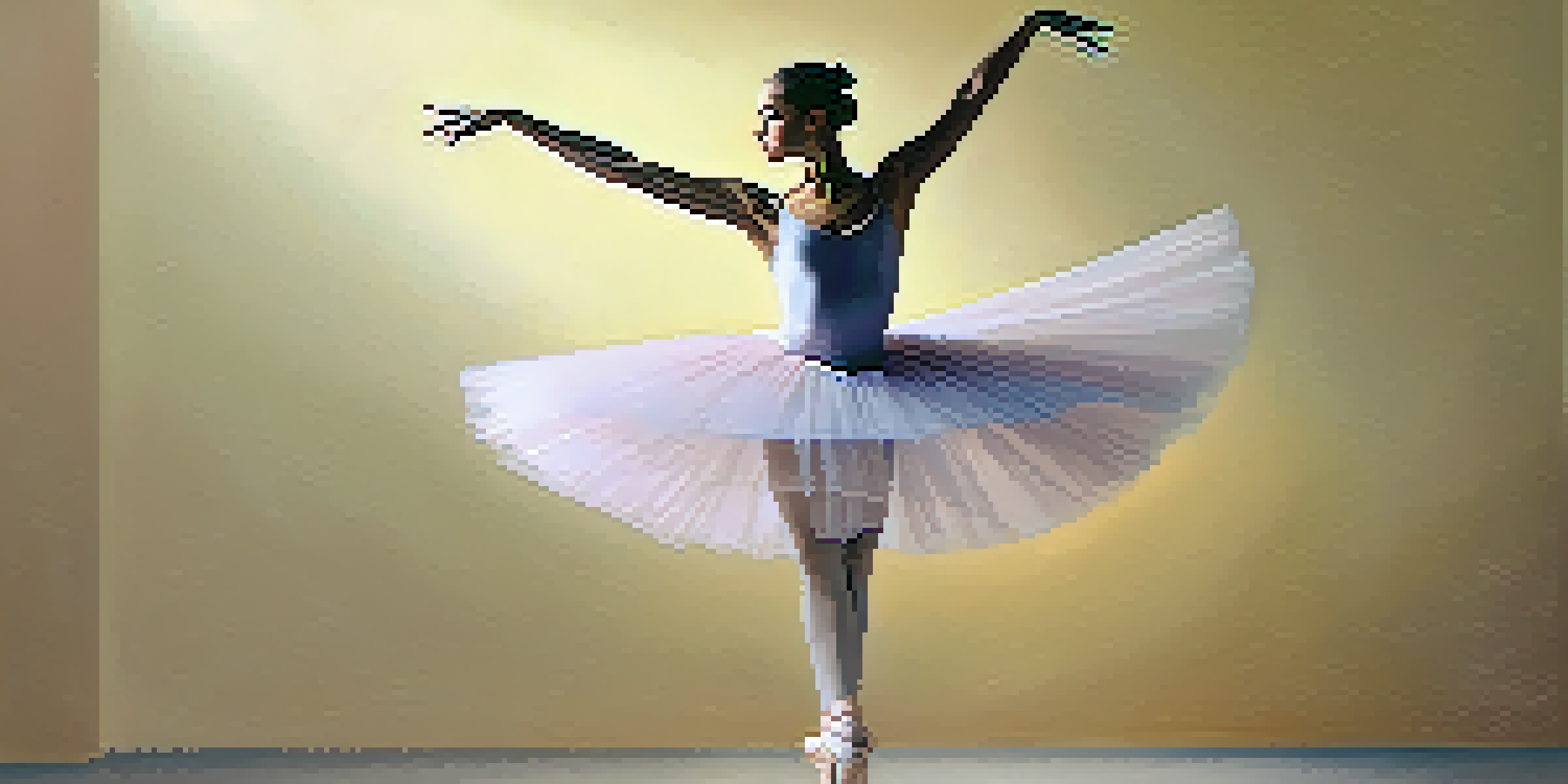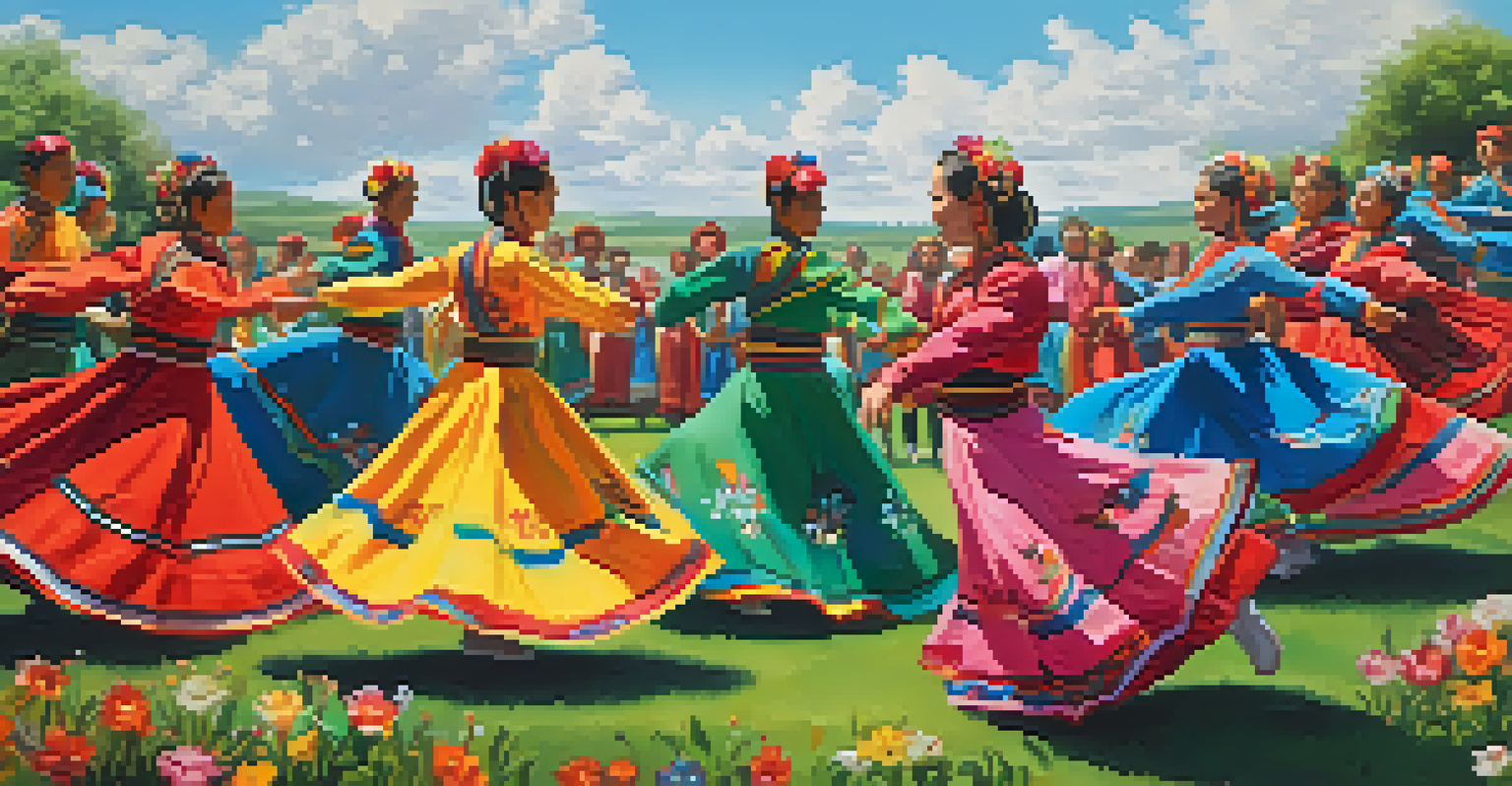The Role of Historical Dance Forms in Contemporary Dance Education

Understanding Historical Dance Forms and Their Origins
Historical dance forms, such as ballet, folk, and court dances, have deep roots that reflect the culture and society of their time. These styles not only showcase unique movements but also tell stories that resonate with audiences even today. By studying these forms, dancers gain insights into the evolution of movement and expression throughout history.
Dance is the hidden language of the soul.
Each dance form carries its own set of techniques and philosophies, often influenced by the social and political climates of the era. For instance, ballet originated during the Renaissance as a form of entertainment for the elite, which shaped its technical precision and grace. Understanding these origins helps contemporary dancers appreciate the art form's lineage and the context in which it developed.
Incorporating historical dance forms into education provides a foundation for students to explore their own creative expression. It allows them to see how past techniques can inform modern styles, creating a rich tapestry of movement and artistry that honors tradition while embracing innovation.
The Influence of Historical Dance on Contemporary Styles
Contemporary dance is often seen as a departure from classical forms, yet it is heavily influenced by them. Many contemporary choreographers draw inspiration from historical dance, reinterpreting classical techniques in new and innovative ways. This blending of styles not only enriches the choreography but also challenges dancers to expand their skill sets.

For example, elements of ballet can be found in the fluidity and precision of contemporary works. Dancers who have trained in both forms can navigate these transitions seamlessly, creating performances that are both technically stunning and emotionally resonant. This cross-pollination of styles encourages a deeper appreciation for the craft and broadens the dancer's repertoire.
Historical Dance Enhances Creativity
Incorporating historical dance forms into education inspires students to explore their own creative expressions and innovate within contemporary styles.
Additionally, historical dance forms provide contemporary dancers with a vocabulary that can enhance their storytelling abilities. By understanding how to convey emotion through movement rooted in history, dancers can create performances that connect with audiences on a deeper level, bridging the gap between the past and the present.
Creating a Curriculum That Incorporates Historical Dance
To effectively teach contemporary dance, educators can create a curriculum that integrates historical dance forms. This approach not only provides students with a solid technical foundation but also encourages them to explore the narratives behind each style. A well-rounded curriculum can include workshops, lectures, and practical classes that highlight various historical forms.
Dance is the joy of movement and the heart of life.
For instance, a course could begin with an introduction to classical ballet techniques, followed by sessions on folk dances from different cultures. This not only diversifies the learning experience but also fosters an environment of cultural appreciation and understanding. Students gain a holistic view of dance as a dynamic art form that evolves over time.
Moreover, incorporating historical dance into the curriculum can inspire creativity in choreography. By studying the techniques and themes of historical forms, students can experiment with their own movement vocabulary, leading to innovative creations that pay homage to the past while pushing the boundaries of contemporary dance.
The Role of Historical Dance in Performer Development
Historical dance forms play a crucial role in the development of well-rounded performers. Understanding the techniques and styles of the past equips dancers with the tools needed to tackle diverse roles in contemporary works. This versatility is increasingly valuable in today's competitive dance landscape, where adaptability is key.
For instance, dancers trained in historical forms often exhibit a strong sense of musicality and rhythm, which can enhance their performance quality. Additionally, the discipline required for mastering these techniques fosters a strong work ethic and dedication—traits that are essential for success in any artistic endeavor. These attributes not only benefit their dance careers but also positively impact their personal growth.
Cultural Context Enriches Dance
Understanding the cultural context of historical dance allows dancers to appreciate the narratives behind movements, leading to more meaningful performances.
Furthermore, exploring historical dance encourages dancers to connect with their own cultural heritage. As they delve into the movements and stories of different eras, they often find personal reflections and connections, enriching their artistic expression. This sense of identity can empower performers to share their unique narratives through dance, fostering a deeper connection with audiences.
Connecting Historical Dance to Cultural Contexts
Understanding the cultural context of historical dance forms is essential for contemporary dance education. Each dance style reflects the values, beliefs, and social dynamics of its time, providing a rich backdrop for exploration. By studying these connections, dancers can gain a greater appreciation for the art form and its impact on society.
For example, folk dances often serve as a celebration of community and tradition, embodying the spirit of a particular culture. By learning these dances, students not only develop their technical skills but also gain insight into the stories and experiences that shape cultural identity. This awareness can lead to more meaningful performances that resonate with audiences on a personal level.
Additionally, recognizing the historical significance of dance can inspire dialogue about social issues and cultural heritage. In a contemporary setting, dancers can use their art to comment on current events or revisit historical injustices through movement. This engagement with social themes adds depth to their performances and fosters a sense of responsibility in sharing cultural narratives.
Historical Dance as a Tool for Emotional Expression
Historical dance forms are not just about technique; they also serve as a powerful medium for emotional expression. Each movement tells a story and evokes feelings, allowing dancers to connect with their audience on a deeper level. By studying these forms, contemporary dancers learn to channel their emotions through movement, enhancing their performance capabilities.
For instance, the graceful lines of ballet can convey elegance and sorrow, while the energetic rhythms of folk dance can express joy and celebration. This emotional versatility empowers dancers to select movements that align with their artistic vision, creating performances that resonate with viewers. As they explore these expressions, dancers develop a stronger sense of self and a more profound connection to their art.
Emotional Expression Through Dance
Historical dance serves as a powerful medium for emotional expression, enabling dancers to connect deeply with their audience and convey personal stories.
Moreover, using historical dance as a means of emotional expression can help dancers process their own experiences. Engaging with the narratives behind these forms can provide a therapeutic outlet, allowing them to navigate their emotions in a constructive way. This personal connection to the art fosters a more authentic performance, as dancers share not just movements, but their own stories.
Promoting Inclusivity Through Historical Dance Education
Incorporating historical dance forms into contemporary education can promote inclusivity and diversity within the dance community. By exploring a wide range of styles, students can appreciate the richness of different cultures and perspectives. This exposure fosters an environment where all forms of dance are valued, encouraging students to embrace their unique identities.
For instance, by teaching dances from various cultures, educators can highlight the similarities and differences in movement and expression. This not only broadens students' understanding of dance but also encourages collaboration and dialogue among diverse groups. Such interactions can lead to innovative choreography that reflects a multitude of influences and ideas.

Furthermore, promoting inclusivity through historical dance helps combat stereotypes and misconceptions about different dance styles. As students engage with a variety of forms, they become advocates for diversity within the dance community, challenging the notion that certain styles are superior to others. This shift in mindset fosters a more supportive and inclusive environment, enriching the overall dance experience for everyone involved.